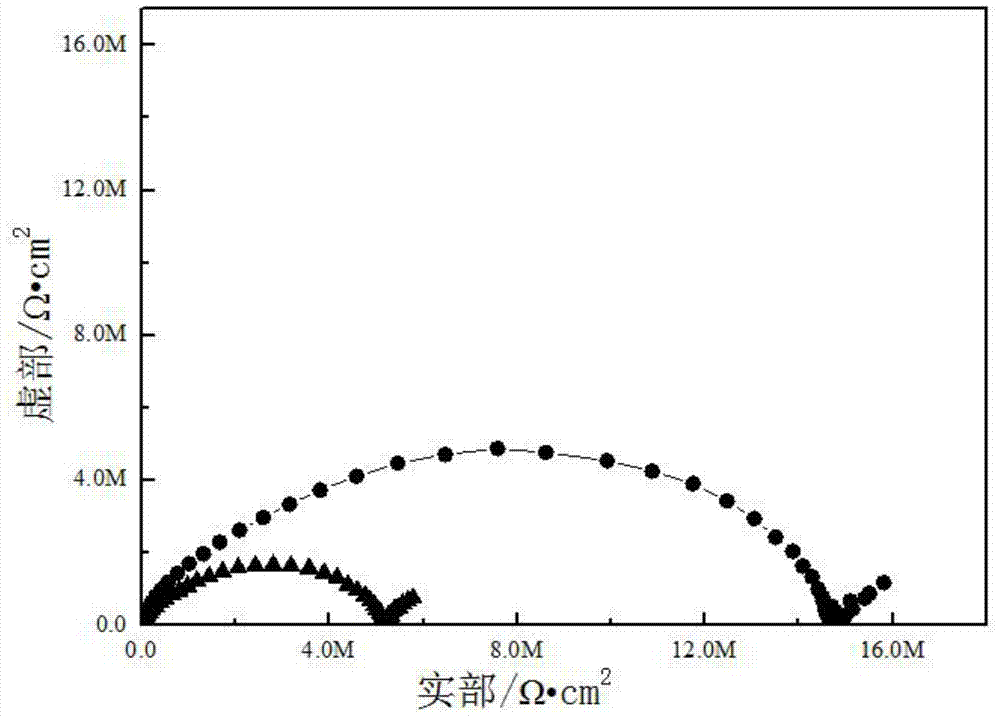Graphene-containing marine anticorrosion antifouling coating and preparation method thereof
A marine anti-corrosion and graphene technology, applied in anti-corrosion coatings, anti-fouling/underwater coatings, epoxy resin coatings, etc., can solve problems such as poor comprehensive performance and high environmental risks, and achieve low cost, simple process equipment, high The effect of anti-corrosion properties
- Summary
- Abstract
- Description
- Claims
- Application Information
AI Technical Summary
Problems solved by technology
Method used
Image
Examples
Embodiment approach 1
[0041] Step 1: Hydroxylation of graphene surface
[0042] Utilize 98wt% concentrated sulfuric acid and 65wt% concentrated nitric acid, press Prepare aqua regia according to the ratio; then press m:V 王水 =1g:600mL scale (measure) to take graphene and aqua regia. The weighed graphene was dispersed in aqua regia and ultrasonically treated in a water bath for 30 minutes. Then the system was heated and stirred in a water bath at 60°C for 6 hours, and the graphene was washed with distilled water until neutral, dried in an oven at 60°C, and ground.
[0043] Step 2: Coupling of Graphene
[0044] The graphene obtained in step 1 and KH602 (N-β-(aminoethyl)-γ-aminopropylmethyldimethoxysilane), according to m 石墨烯 :m KH-602 The mass ratio of =1mg:3mg is dissolved in a small amount of deionized water, stirred evenly, and ultrasonically dispersed for 30min. Thereafter, it was heated and stirred with a magnetic stirrer at 60°C for 8 hours, and the modified graphene was separated by cent...
experiment approach 2
[0052] Step 1: Hydroxylation of graphene surface
[0053] Using 98% concentrated sulfuric acid and 65% concentrated nitric acid, press Prepare aqua regia according to the ratio; then press m:V 王水 =1g:610mL scale (measure) to take graphene and aqua regia. The weighed graphene was dispersed in aqua regia and ultrasonically treated in a water bath for 30 minutes. Then the system was heated and stirred in a water bath at 60°C for 6 hours, and the graphene was washed with distilled water until neutral, dried in an oven at 60°C, and ground.
[0054] Step 2: Coupling of Graphene
[0055] The graphene obtained in step 1 and KH602 (N-β-(aminoethyl)-γ-aminopropylmethyldimethoxysilane), according to m 石墨烯 :m KH-602The mass ratio of =1mg:4mg is dissolved in a small amount of deionized water, stirred evenly, and ultrasonically dispersed for 30min. Thereafter, it was heated and stirred with a magnetic stirrer at 60°C for 9 hours, and the modified graphene was separated by centrifugat...
experiment approach 3
[0063] Step 1: Hydroxylation of graphene surface
[0064] Using 98% concentrated sulfuric acid and 65% concentrated nitric acid, press Prepare aqua regia according to the ratio; then press m:V 王水 =1g:620mL scale (measure) to take graphene and aqua regia. The weighed graphene was dispersed in aqua regia and ultrasonically treated in a water bath for 30 minutes. Then the system was heated and stirred in a water bath at 60°C for 6 hours, and the graphene was washed with distilled water until neutral, dried in an oven at 60°C, and ground.
[0065] Step 2: Coupling of Graphene
[0066] The graphene obtained in step 1 and KH602 (N-β-(aminoethyl)-γ-aminopropylmethyldimethoxysilane), according to m 石墨烯 :m KH-602 The mass ratio of =1mg:4mg is dissolved in a small amount of deionized water, stirred evenly, and ultrasonically dispersed for 30min. Thereafter, it was heated and stirred with a magnetic stirrer at 60°C for 10 hours, and the modified graphene was separated by centrifug...
PUM
 Login to View More
Login to View More Abstract
Description
Claims
Application Information
 Login to View More
Login to View More - R&D
- Intellectual Property
- Life Sciences
- Materials
- Tech Scout
- Unparalleled Data Quality
- Higher Quality Content
- 60% Fewer Hallucinations
Browse by: Latest US Patents, China's latest patents, Technical Efficacy Thesaurus, Application Domain, Technology Topic, Popular Technical Reports.
© 2025 PatSnap. All rights reserved.Legal|Privacy policy|Modern Slavery Act Transparency Statement|Sitemap|About US| Contact US: help@patsnap.com



